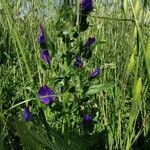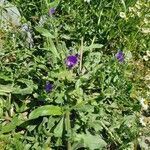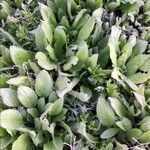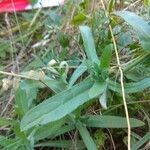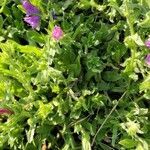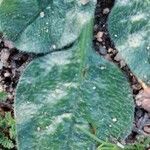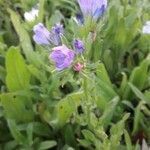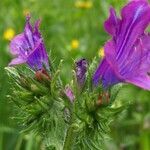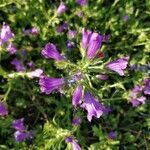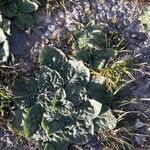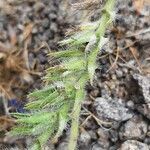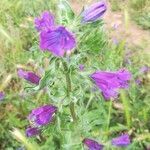Erect annual to biennial herb with 1–many flowering stems 20–65 cm. tall; radical leaves ovate to oblanceolate, 5–28 cm. long, 1–3.5 cm. wide, adpressed setose with lateral nerves distinct; cauline leaves oblong to lanceolate, the upper cordate or truncate at the base, all with adpressed rather soft hairs.. Cymes usually distinctly stalked, lengthening after flowering to 25–30 cm.. Calyx 0.7–1.2 cm. long, lengthening to 1.7 cm. in fruit.. Corolla blue turning purple then pink or entirely white, 1.8–3.2 cm. long, with hairs restricted to the veins and margins; ring of 10 distinct pilose lobes within the tube.. Lower pair of stamens exserted, the others included or only slightly exserted; filaments with long woolly hairs.. Style included, densely hispidulous below, bifid for ± 1 mm.. Nutlets black or grey-brown, ovoid-bipyramidal, 2.3–3 × 2–2.5 mm. with prominent ventral and distinct dorsal keel and short suberect beak, tuberculate and faintly striate.. Fig. 22.
Annual or biennial herb, with 1-many flowering stems, up to 0.8 m high. Stems erect or decumbent. Leaves petiolate or sessile; basal leaves with blade broadly ovate to narrowly obovate, 50-300 x 10-70 mm, apex rounded to somewhat acute, decurrent, base attenuate, lateral veins prominent on both surfaces; petiole up to 55 mm long; cauline leaves sessile; blade narrowly ovate. Flowers: in helicoid cymes; stamens with lower pair long-exserted, other 3 enclosed; filaments with long hairs; calyx up to 12 mm long in fruit; corolla broadly funnel-shaped, 10-20 mm long, glabrous except for hairs on veins and margins of outer surface, blue or deep purplish blue; Sep.-Mar. Fruit with nutlets, 2.0-3.0 x 2.0-2.5 mm, greyish brown, rugose, tuberculate.
Annual or biennial herb, with 1-many flowering stems, up to 0.8 m high. Stems erect or decumbent. Leaves: basal leaves with blade broadly ovate to narrowly obovate, 50-300 x 10-70 mm, base attenuate, apex rounded to somewhat acute, decurrent, lateral veins prominent on both surfaces, petioles up to 55 mm long; cauline leaves sessile, blade narrowly ovate. Flowers in helicoid cymes. Calyx up to 12 mm long in fruit. Corolla broadly funnel-shaped, 10-20 mm long, glabrous except for hairs on veins and margins of outer surface, blue or deep purplish blue. Stamens with lower pair long-exserted, other 3 enclosed; filaments with long hairs. Flowering time Sept.-Mar. Fruit with nutlets 2-3 x 2.0-2.5 mm, greyish brown, rugose, tuberculate.
Hispid annual or biennial herb to c. 90 cm high. Basal lvs to c. 15 × 3.5 cm, linear-lanceolate to ovate-lanceolate; base attenuate and petiolate; apex obtuse; upper cauline lvs smaller, sessile, lanceolate to oblong, ± cordate at base. Infl. with 1-several branches; branches becoming spike-like or paniculate. Calyx 9-12 mm long; lobes linear-lanceolate, much < corolla tube. Corolla 20-30 mm long, funnelform, reddish in bud, becoming purplish blue or blue; upper lobes > lower; 2 stamens long-exserted, others included; filaments deep pink; anthers blue. Nutlets 2-3 mm long, angular.
Herb, 0.2-0.6 m high. Basal leaves ovate to spathulate with prominent lateral veins; cauline leaves oblong to lanceolate with cordate base. Corolla 18-30 mm long, with 2 stamens exserted from corolla tube. Flowers blue becoming pink through purple.
Hairy annual or biennial to 65 cm. Basal leaves ovate to oblanceolate, lateral veins prominent. Flowers blue fading to pink, oblique and unequally lobed, sparsely hairy on veins and margins. Nutlets rugose.
